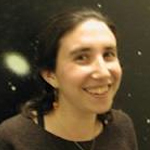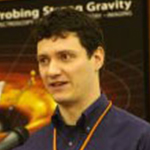Seminars are held at 4:00 PM on Tuesdays in Room F160
on the first floor of the Technological Institute (2145 Sheridan Road) unless otherwise noted
Winter Quarter 2014
| Date | Speaker / Seminar | Host | |
| Jan. 14 |  |
Chuck Hailey The Nuclear Spectroscopic Telescope Array (NuSTAR), with its twin, focusing, hard X-ray telescopes, offers a view of the 10-79 keV energy band with unprecedented sensitivity compared to previous non-focusing missions. In its first 18 months of operation NuSTAR has spent considerable time observing the central ~ square degree of the Galactic Center. I will discuss recent results from these Galactic Center observations. In addition to the detection of dozens of hard X-ray point sources, including a number of transient sources, NuSTAR has also detected many diffuse filamentary structures as high energy X-ray sources, and provided insight into the possible origin of the energetic electrons powering these structures. I will also discuss the NuSTAR discovery and possible origin of a diffuse X-ray emission at > 20 keV which is centered on the Galactic Center. I will end with a brief description of the remaining Galactic Center observations to be done before the end of the two year NuSTAR mission. |
Farhad Zadeh |
| Jan. 21 |  |
Jenny Greene I discuss two essential aspects of elliptical galaxy formation: how they get their stars, and how they lose their gas. For the former, I use integral-field observations of local massive galaxies to study the stellar populations and kinematics of stars at large radius, to understand the origin of the size growth of elliptical galaxies. Then I focus on black hole feedback as a means of clearing gas from massive galaxies. I show that luminous obscured quasars have ubiquitous, round ionized outflows with very high gas dispersions of nearly 1000 km/s out to 20 kpc. Finally, if time permits I will combine these two themes and present our recent search for sub-pc supermassive black hole binaries. |
Laura Trouille |
| Jan. 28 |  |
Pascale Garaud I will present various hydrodynamical and hydromagnetic mixing processes thought to occur in stars, ranging from microscopic to macroscopic, and present new numerical and analytical results concerning their mixing efficiency for angular momentum transport and compositional transport. In particular, I will focus on double-diffusive convection (through fingering convection and semiconvection), and large-scale meridional flows/magnetic fields. |
Elizabeth Hicks |
| Feb. 11 |  |
Jason Dexter The center of the Milky Way is an excellent laboratory for understanding star formation and black hole feeding and feedback in a normal galactic nucleus. In addition, the Galactic center black hole, Sgr A*, provides a remarkable opportunity to study strong gravity. Very long baseline interferometry observations at millimeter wavelengths are now spatially resolving event horizon scales around Sgr A*. This Event Horizon Telescope experiment may detect the black hole "shadow," and near-infrared astrometry with the VLTI instrument GRAVITY will achieve similar resolution in the next few years. In both cases, interpreting the data requires physical modeling. I will discuss the construction of relativistic emission models from numerical simulations of black hole accretion flows and jets, what we've learned from their comparison with current data, and the prospects for detecting signatures of strong gravity in future observations. Pulsars orbiting Sgr A* could provide additional, independent tests of general relativity. I will argue that the recent discovery of the first detection of a pulsar close to Sgr A*, a rare magnetar outburst, implies the presence of an unusual pulsar population in the Galactic center. |
Daryl Haggard |
| Feb. 25 |  |
Andrey Kravtsov Galaxy formation is a complex, hierarchical, highly non-linear process, which involves gravitational collapse of dark matter and baryons, supersonic, highly compressible and turbulent flows of gas, star formation, stellar feedback, as well as heating, cooling, and chemical processes that affect the gas and, indirectly, the stellar and dark matter distributions. Nevertheless, despite the apparent complexity of processes accompanying galaxy formation, galaxies exhibit a number of striking regularities, such as tight correlations between galaxy sizes, masses, luminosities, and internal velocities and surprisingly tight correlations between properties of stars and gas in galaxies and the mass and extent of their parent halos dominated by dark matter. Existence of such correlations indicates that powerful processes operate to bring order out of chaos. Understanding what these processes are and how they operate is not only fascinating scientifically, but is critical for interpreting the avalanche of current and future observations of galaxies across cosmic time. I will describe recent progress in our understanding of how such regularities can arise in a seemingly chaotic and nonlinear process of galaxy formation. |
Claude-André Faucher-Giguère |
| March 4 |  |
Neal Dalal The abundance of dark matter substructure in the halos of ordinary galaxies is sensitive to both the physics of dark matter and the physics of inflation in the early universe. Strong gravitational lensing provides one of the only probes of the abundance of DM halo substructure, but existing constraints on substructure from lensing have been weak because of the small sample sizes available. I will describe how the advent of the Atacama Large Millimeter/submillimeter Array (ALMA) has opened a new window onto DM substructure. Large numbers of lensed, dusty star-forming galaxies at high redshift have been discovered by Herschel and the South Pole Telescope, and ALMA observations of these lensed systems will allow reconstruction of the mass distributions of the lensing galaxies with unprecedented resolution. I will describe early results from this program, and I will discuss forecasts for ALMA as a probe of the properties of dark matter. |
Yoram Lithwick |
| March 11 |  |
Quinn Konopacky Directly imaged exoplanets offer a new window into the rapidly evolving field of planet formation and evolution. The ability to separate the light of the planet from its host star is extremely advantageous for studying Jovian planetary atmospheres. The wide projected separations (~15 to 100 AU) of these planets provide insight into the orbital dynamics of long period objects. The combination of dynamical and atmospheric characterization can give clues about how these objects form. To demonstrate this new insight, I will discuss our team's results from an ongoing monitoring campaign of the HR 8799 directly imaged multi-planet system using the Keck Observatory adaptive optics system. High precision astrometry (~1 mas) has provided constraints on the orbital properties of the four HR8799 planets. Moderate resolution (R~4000) spectroscopy has given precise estimates of the planets' effective temperature, surface gravity, and composition, leading to tantalizing clues about their formation. I will also discuss the successful first light runs of the Gemini Planet Imager (GPI), and instrument designed specifically to image and characterize young, widely separated Jovian planets. I will highlight some early results with GPI and describe the upcoming GPI Exoplanet Survey (GPIES), a three year campaign that will revolutionize our understanding of this fascinating planet population. |
Nate Kaib |
| March 18 |  |
Andrew Howard Earth-sized exoplanets and their slightly larger ‘super-Earth’ cousins are the most abundant planets orbiting close to Sun-like stars. These planets have diverse physical compositions and poorly understood origins. My talk will trace the discovery and early characterization of these small worlds through Doppler surveys, the Kepler mission, and atmospheric transmission spectroscopy. I will focus on three recent results from my group. First, I will describe our measurement of the mass of the planet Kepler-78b, the only Earth-sized planet with a measured mass and radius outside of the Solar System. The bulk density of 5 grams per cubic centimeter suggests a rocky composition with an insubstantial atmosphere, similar to Earth. Second, I will discuss my team’s recent measurement of the fraction of Sun-like stars having Earth-sized planets orbiting in the habitable zone. By re-analyzing the Kepler photometry to determine an independent, calibrated planet catalog, we found that 22 percent of Sun-like stars have a planet that is 1-2 times the size of Earth orbiting in the habitable zone. Warm, Earth-sized planets appear to be common. Finally, I will describe recent measurements suggesting that most planets larger than about 1.5 times Earth size are gas dominated while those smaller are mostly rocky. |
Fred Rasio |